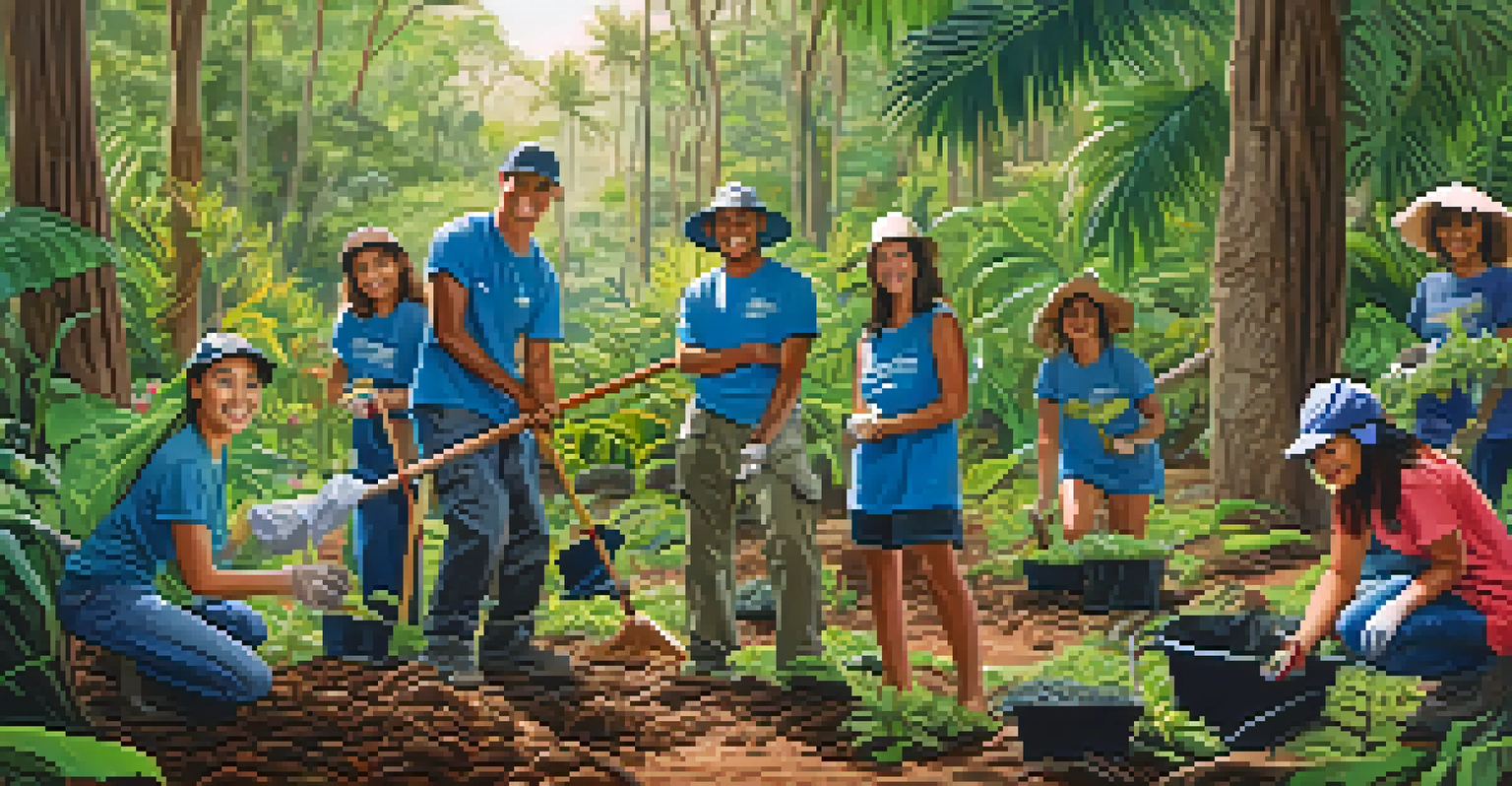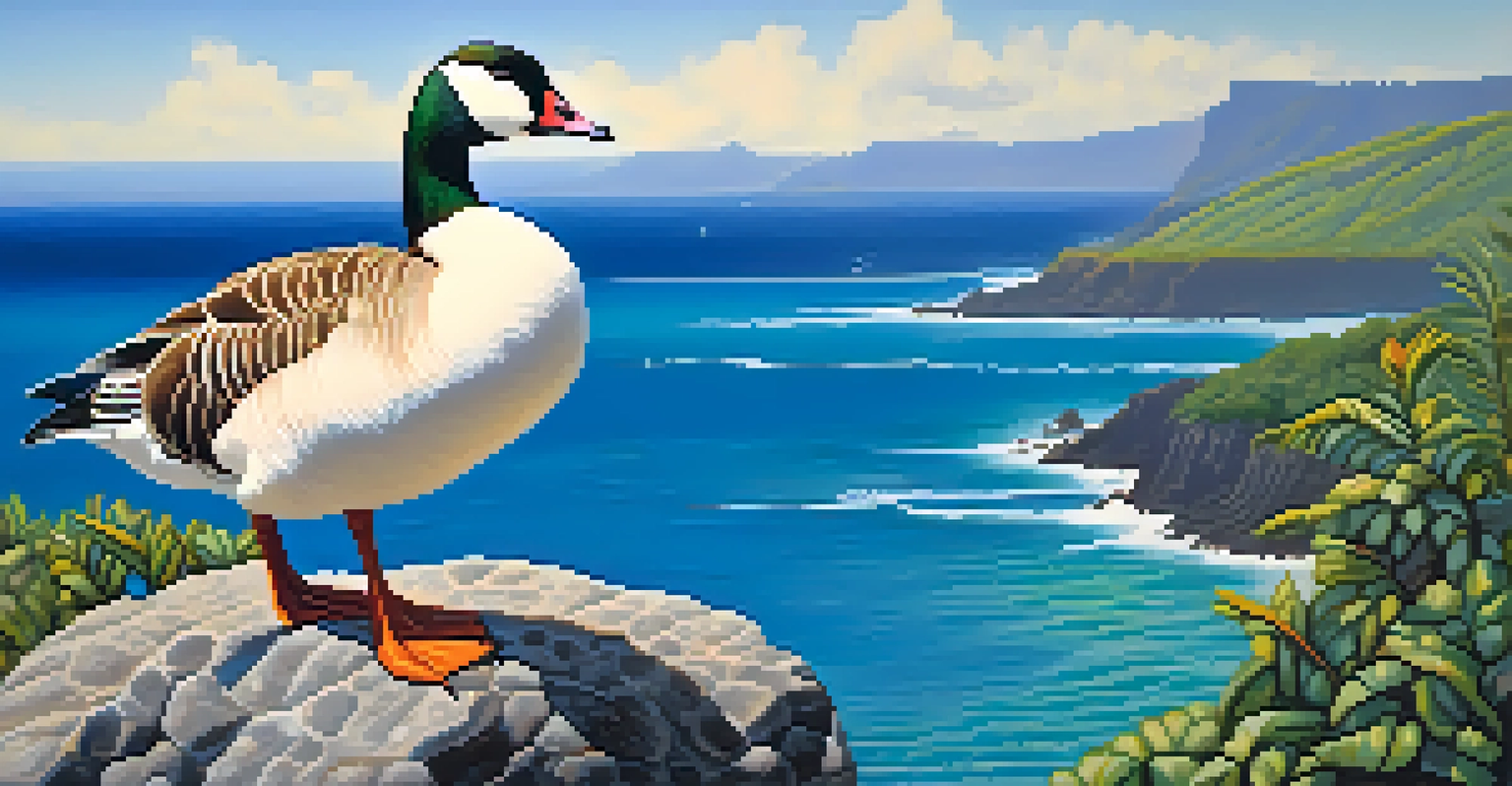The Impact of Invasive Species on Hawaii's Ecosystems

Understanding Invasive Species in Hawaii
Invasive species are non-native organisms that, when introduced to an ecosystem, can cause significant harm. In Hawaii, these species often outcompete native flora and fauna, leading to a decline in biodiversity. The islands' unique environment makes them particularly vulnerable, as many native species evolved without natural predators.
In the end, we will conserve only what we love; we will love only what we understand; we will understand only what we are taught.
To put it simply, invasive species can be likened to uninvited guests at a party who take over the space, leaving little room for the original hosts. This takeover can lead to the extinction of native species, disrupting the delicate balance that has existed in Hawaii for millions of years. Understanding this concept is key to grasping the broader impact on the islands' ecosystems.
Efforts to combat invasive species are ongoing, but the challenge is immense. With limited resources and vast areas to cover, conservationists are often working against the clock. The urgency to protect Hawaii's fragile ecosystems has never been more critical.
Key Invasive Species Threatening Hawaii
Among the most notorious invasive species in Hawaii are the mongoose, feral pigs, and various plant species like the albizia tree. The mongoose was introduced to control rat populations but has instead become a predator of native birds, further endangering them. Feral pigs, on the other hand, wreak havoc on the land, rooting around and destroying the habitats of native plants.

Additionally, invasive plants like the albizia tree grow rapidly and can outcompete native trees for sunlight and nutrients. This not only affects the plants themselves but also the countless species that rely on native plants for survival. It’s similar to a game of musical chairs, where the native species are often left without a seat.
Invasive Species Harm Biodiversity
Invasive species in Hawaii disrupt the balance of native ecosystems, leading to a decline in biodiversity.
The presence of these invasive species highlights the need for awareness and action. As residents and visitors alike, understanding these threats is crucial in preserving the natural beauty of Hawaii. The more we know, the better equipped we are to help.
Impact on Native Wildlife in Hawaii
Hawaii is home to a remarkable array of unique wildlife, including birds like the Hawaiian goose and the Hawaiian monk seal. Unfortunately, invasive species pose a severe threat to these native animals. For instance, introduced predators such as rats and cats feast on the eggs and chicks of native birds, leading to declining populations.
The greatest threat to our planet is the belief that someone else will save it.
Moreover, habitat destruction caused by invasive plants further exacerbates the situation. As these non-native species take over, they reduce the available space and resources for native wildlife, creating a ripple effect throughout the ecosystem. Imagine a neighborhood where residents are pushed out of their homes; the wildlife faces similar struggles.
Conservation efforts are essential to protect these vulnerable species. By controlling invasive populations and restoring native habitats, we can help ensure that Hawaii's unique wildlife continues to thrive for generations to come.
Effects on Native Plants and Biodiversity
Native plants in Hawaii have adapted to the specific conditions of their environment over thousands of years. However, invasive plant species often disrupt these adaptations, leading to a decline in biodiversity. This loss of diversity is concerning, as it can make ecosystems less resilient to environmental changes and diseases.
Invasive plants can quickly dominate landscapes, forming dense thickets that choke out native vegetation. This phenomenon can be likened to a thick fog rolling in, obscuring everything in its path, leaving little light for the native plants to thrive. Without a diverse plant community, the entire ecosystem suffers.
Economic Impact of Invasive Species
The presence of invasive species adversely affects Hawaii's agriculture and tourism industries, resulting in economic losses.
Efforts to control these invasive plants are in place, but they require community involvement and public awareness. By supporting local conservation projects, individuals can play a vital role in preserving Hawaii's botanical heritage and maintaining the delicate balance of its ecosystems.
Economic Consequences of Invasive Species
The impact of invasive species in Hawaii extends beyond the environment; it also has significant economic implications. Agriculture, tourism, and fishing industries suffer when invasive species disrupt local ecosystems. For example, invasive pests can damage crops, leading to financial losses for farmers and increased prices for consumers.
Furthermore, the tourism industry, which plays a crucial role in Hawaii's economy, can be negatively impacted as well. Tourists flock to the islands for their natural beauty and unique landscapes, but invasive species can diminish these attractions. Imagine visiting a picturesque park only to find it overrun with invasive plants; it just wouldn't have the same appeal.
Addressing these economic challenges requires a collective effort from both the government and local communities. By investing in conservation programs and promoting awareness, Hawaii can work towards a more sustainable future that benefits both its ecosystems and its economy.
Community Involvement in Conservation Efforts
Community involvement is vital in the fight against invasive species in Hawaii. Local residents, organizations, and volunteers play a crucial role in monitoring and controlling invasive populations. By participating in clean-up events and educational programs, community members can make a tangible difference in preserving their environment.
One effective approach is the establishment of 'Adopt-a-Park' programs, where volunteers take responsibility for maintaining local parks and natural areas. This not only helps to remove invasive species but also fosters a sense of pride and stewardship within the community. It's like being part of a team working towards a common goal, creating a stronger bond among members.
Community Role in Conservation
Local community involvement is essential for monitoring and controlling invasive species, fostering a culture of environmental stewardship.
Encouraging community action can lead to greater awareness of the issue and foster a culture of sustainability. When individuals are informed and engaged, they can become powerful advocates for their environment—ensuring that future generations will enjoy the beauty of Hawaii's unique ecosystems.
Future Strategies for Managing Invasive Species
Looking ahead, managing invasive species in Hawaii requires innovative strategies and collaboration among various stakeholders. One promising approach is the use of technology, such as drones and remote sensing, to monitor and map invasive populations more effectively. This can help conservationists target their efforts and allocate resources more efficiently.
Additionally, restoring native ecosystems through reforestation and habitat rehabilitation can create a stronger resistance against invasive species. By nurturing the natural environment, we can help ensure that native plants and animals have a fighting chance. Think of it as giving a team the training they need to compete; a healthier ecosystem is better equipped to withstand challenges.

Ultimately, a combination of technology, community engagement, and education will be crucial in combating invasive species. By fostering a collaborative approach, we can protect Hawaii's rich biodiversity and create a sustainable future for the islands.